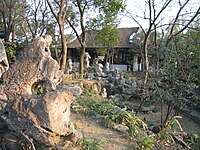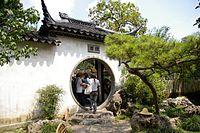Suzhou Classical Gardens
| Suzhou Classical Gardens | |
|---|---|
|
UNESCO world heritage |
|

|
|
| Stone bridge in the humble official's garden |
|
| National territory: |
|
| Type: | Culture |
| Criteria : | (i), (ii), (iii), (iv), (v) |
| Reference No .: | 813 |
| UNESCO region : | Asia and Pacific |
| History of enrollment | |
| Enrollment: | 1997 (session 21) |
| Extension: | 2000 |
Suzhou Classical Gardens is a UNESCO- listed World Heritage Site in China . The cultural heritage includes nine gardens in Suzhou City in east China 's Jiangsu Province . The gardens from the 11th to 19th centuries are outstanding masterpieces of Chinese garden art , which strives to recreate natural landscapes on a small scale. In their carefully crafted design, the gardens reflect the profound importance of natural beauty in Chinese culture.
background
Suzhou is located in a basin on the lower reaches of the Yangtze (長江 "Long River") along the Tai Hu (太湖, "Tai Lake"). The city was founded in 514 BC. BC as the capital of the Kingdom of Wu and has been the region's political, economic and cultural center ever since.
The earliest gardens in Suzhou date back to the time the city was founded in the 6th century BC. During the Ming and Qing dynasties, and especially from the 16th to 17th centuries, the city's prosperity enabled 200 gardens to be created within the city walls over time. Due to the quality and richness of the gardens, Suzhou has been called an "earthly paradise".
The classic Suzhou garden is a microcosm of the world, represented by the basic design elements water, stones, plants and buildings. He succeeds in combining two seemingly irreconcilable human endeavors - to live in a comfortable house and at the same time to live in nature. The gardens mimick a natural landscape and thus serve intellectual and emotional needs in accordance with the philosophical teachings of Laozi and Zhuangzi . Artificially created hills and watercourses are planted with trees, bushes and flowers and are supplemented by a large number of small and large structures that serve a wide variety of purposes: meditation , reading and writing, drinking tea as well as playing and listening to music. The buildings are richly decorated and furnished in traditional Chinese style. Calligraphic inscriptions relating to Chinese philosophy and literature as well as ancient steles add to the richness of the gardens.
enrollment
The first four gardens were added to the World Heritage List in 1997. At the same time, the World Heritage Committee recommended extending the protection status to other historic areas of Suzhou and taking measures to preserve the historic city. The connection of the city's canal system with the gardens represents a cultural value that extends beyond the four nominated gardens. In accordance with this recommendation, another five gardens were proposed for inclusion in the World Heritage List, with protection zones now also being designated beyond the gardens. This proposal for an extension was accepted at the 24th meeting of the World Heritage Committee from November 27th to December 2nd, 2000. The registrations were based on criteria (i), (ii), (iii), (iv) and (v):
(i): Suzhou Classical Gardens, influenced by traditional Chinese craftsmanship and artistry first introduced through the freehand brushwork of traditional Chinese paintings, embody the refined sophistication of traditional Chinese culture. This embodiment of artistic perfection has earned them a reputation as the most creative garden art masterpieces of ancient China.
(ii): Over a period of more than 2000 years, a unique and at the same time systematic landscape design was created for these special types of gardens. Their planning and design as well as the construction techniques and artistic effects used had a significant influence on the development of landscaping both in China and worldwide.
(iii): The classical gardens of Suzhou originated from the desire of ancient Chinese scholars to create harmony with nature and at the same time cultivate its character. They are excellent legacies of the wisdom and tradition of ancient Chinese scholars.
(iv): The Classical Gardens of Suzhou are the most impressive examples of the culture that found expression in the landscaping of the eastern Yangtze River from the 11th to 19th centuries. The underlying philosophy, literature, arts and crafts found in architecture as well as gardening and handicrafts reflect the most significant achievements of the social, cultural, scientific and technological developments of that time.
(v): These classic Suzhou gardens are excellent examples of the harmonious relationship that is achieved between traditional Chinese residences and artfully arranged nature. They show the lifestyle, manners and customs of the eastern Yangtze delta from the 11th to the 19th century.
List of gardens
The first eight gardens are relatively close to each other in the Gusu district , the deep reflection garden about 25 km south of the others in Tongli in the Wujiang district .
| Ref.No. | image | Designations |
Core zone (K) buffer zone (P) location |
Year of enrollment |
|---|---|---|---|---|
| 813-001 |
 (more pictures) |
Garden of the Humble Administrator 拙政园(Zhuozheng Yuan) The Humble Administrator's Garden |
K: 5,195 ha P: - Location |
1997 |
| 813-002 |
 (more pictures) |
Lingering Garden 留 元 (Liu Yuan) The Lingering Garden |
K: 2,331 ha P: - location |
1997 |
| 813-003 |
 (more pictures) |
Garden of the Master of Nets 网 师 园 (Wangshi Yuan) The Master-of-Nets Garden |
K: 0.540 ha P: –– location |
1997 |
| 813-004 |
 (more pictures) |
Huanxiu-Berghaus 环 秀 山庄 (Huanxiu-Shanzhuang) The Mountain Villa with Embracing Beauty |
K: 0.218 ha P: - location |
1997 |
| 813-005 |
 (more pictures) |
Garden of the Dark Green Wave沧浪亭 (Canglang Ting) The Canglang Pavilion |
K: 1.174 ha P: 16.362 ha site |
2000 |
| 813-006 |
 (more pictures) |
Lion Forest Garden 狮子林(Shizi Lin) The Lion Forest Garden |
K: 0.874 ha P: 4.790 ha site |
2000 |
| 813-007 |
 (more pictures) |
Garden of Cultivation 艺 圃 (Yì Pǔ) The Garden of Cultivation |
K: 0.380 ha P: 1.117 ha site |
2000 |
| 813-008 |
 (more pictures) |
Couple's Garden 耦 园 (Ou Yuan) The Couple's Retreat |
K: 0.789 ha P: 3.039 ha location |
2000 |
| 813-009 |
 (more pictures) |
Garden for deep reflection 退 思 园 (Tuisi-Yuan) The Retreat & Reflection Garden |
K: 0.421 ha P: 1.531 ha site |
2000 |
Web links
- Classical Gardens of Suzhou / Jardins classiques de Suzhou on the UNESCO World Heritage Center website ( English and French ).
- Suzhou Classical Gardens. Chinareise.com, accessed January 19, 2018 .
- Top 10 Most Beautiful Gardens in Suzhou and Tongli and Mudu Water Villages. Chinareise.com, accessed January 19, 2018 .
Notes and individual references
- ↑ Original name: English Classical Gardens of Suzhou , French Jardins classiques de Suzhou , German name according to the World Heritage List. German UNESCO Commission , accessed on January 19, 2018 .
- ^ A b Classical Gardens of Suzhou. In: whc.unesco.org. UNESCO World Heritage Center, accessed January 19, 2018 .
- ^ Inscription: The Classical Gardens of Suzhou (China). Decision: CONF 208 VIII.C. UNESCO World Heritage Center, accessed January 20, 2018 .
- ^ The Classical Gardens of Suzhou. (PDF, 482 kB) Advisory Body Evaluation (ICOMOS). UNESCO World Heritage Center, September 1997, accessed January 19, 2018 .
- ^ The classical gardens of Suzhou (extension). (PDF, 28 kB) Advisory Body Evaluation (ICOMOS). UNESCO World Heritage Center, September 2000, accessed January 19, 2018 .

